|
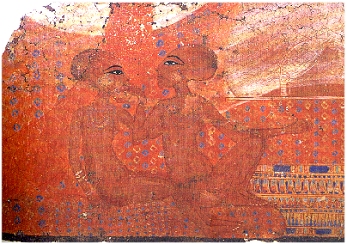 This
bright fresco from the palace in Akhetaten
is one of my favourites. Only this lower corner was preserved,
showing two of Akhenaten's young daughters. This
bright fresco from the palace in Akhetaten
is one of my favourites. Only this lower corner was preserved,
showing two of Akhenaten's young daughters.
Ashmolean Museum, Oxford, height
30 cm.
Image source: Christine Hobson,
The
World of the Pharaohs, New York: Thames and Hudson, 1987,
p.109
Other versions on the web:
Daughters
of Akhenaten (better contrast), House
in Tell el-Amarna
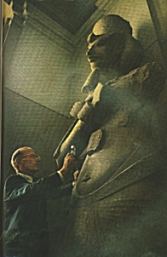 The
colossal statue of Akhenaten seen here as studied by Ray Winfield
Smith. This picture gives a feeling for the size of the statues
(from Karnak) and the perspective you see them through in real
life (Smith is standing on step-ladder, I believe). The
colossal statue of Akhenaten seen here as studied by Ray Winfield
Smith. This picture gives a feeling for the size of the statues
(from Karnak) and the perspective you see them through in real
life (Smith is standing on step-ladder, I believe).
Egyptian Museum, Cairo
Image source: Ray Winfield
Smith, Emory Kristof, "Computer Helps Scholars Re-Create
an Egyptian Temple", National
Geographic, November 1970, Vol. 138, No. 5, p. 653.
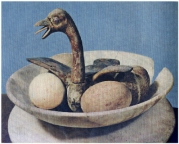 Here
a first spirited gosling breaks free from an egg. This wooden
bird sat atop an unguent jar in Tutankhamun's tomb. It demonstrates
the attention paid by artists of the Amarna period to the nature
around them. Here
a first spirited gosling breaks free from an egg. This wooden
bird sat atop an unguent jar in Tutankhamun's tomb. It demonstrates
the attention paid by artists of the Amarna period to the nature
around them.
Image source: "Tutankhamun's
Golden Trove," National
Geographic, October 1963, Vol. 124, No 4, p. 646.
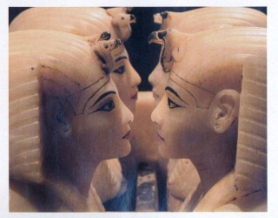 The
canopic-jar lids from Tutankhamun's tomb are particularly beautiful.
The art from Tutankhamun's tomb is thought to be in part a collection
of artifacts originally intended for Akhenaten, Nefertiti, or
other Amarna nobles, and demonstrates the art of the final phases
of the Amarna period. The
canopic-jar lids from Tutankhamun's tomb are particularly beautiful.
The art from Tutankhamun's tomb is thought to be in part a collection
of artifacts originally intended for Akhenaten, Nefertiti, or
other Amarna nobles, and demonstrates the art of the final phases
of the Amarna period.
Image source: Kent R. Weeks,
"Valley of the Kings," National
Geographic, September 1998, Vol. 194, No. 3, p. 28.
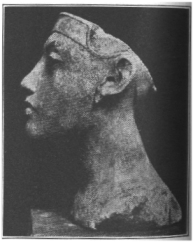 This
unfortunately poor picture shows a young, idealist Pharaoh Akhenaten.
I see a rare innocent, hopeful look about this painted sandstone
piece, from his early reign. This
unfortunately poor picture shows a young, idealist Pharaoh Akhenaten.
I see a rare innocent, hopeful look about this painted sandstone
piece, from his early reign.
Staatliche Museum, Berlin, approx.
8 in.
Image source: Helen Gardner,
Art through the Ages, New York: Harcourt, Brace and Company, 1936,
p. 56, fig. 79
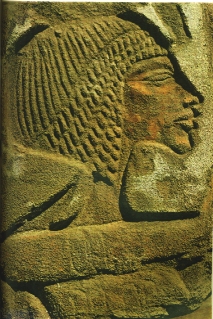 This
relief from a talatat block shows Nefertiti. Though we wouldn't
usually call these somewhat exaggerated features beautiful, it
shows her delicate features. This piece dates from Akhenaten's
early reign, at Karnak, when the new form of Amarna art was first
being experimented with. This
relief from a talatat block shows Nefertiti. Though we wouldn't
usually call these somewhat exaggerated features beautiful, it
shows her delicate features. This piece dates from Akhenaten's
early reign, at Karnak, when the new form of Amarna art was first
being experimented with.
Image source: Ray Winfield
Smith, Emory Kristof, "Computer Helps Scholars Re-Create
an Egyptian Temple", National
Geographic, November 1970, Vol. 138, No. 5, p. 645
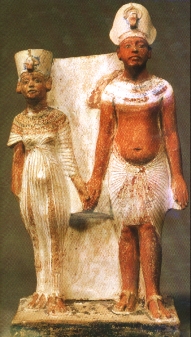 This
touching little statuette of Akhenaten and Nefertiti is probably
from a domestic shrine in Akhetaten. The King and Queen are sweetly
holding hands. It is from somewhat later in their reign. This
touching little statuette of Akhenaten and Nefertiti is probably
from a domestic shrine in Akhetaten. The King and Queen are sweetly
holding hands. It is from somewhat later in their reign.
Painted limestone, height 22.2
cm
Image source: Lawrence M.
Berman, Bernadette Letellier, Pharaohs:
Treasures of Egyptian Art from the Louvre, Cleveland: Cleveland
Museum of Art, 1996, p. 61.
 This
is a floor-painting I believe is from Akhetaten (someone correct
me if I'm wrong). It shows the trees and the pool from intermixed
angles, to show the best parts of each component. I like it for
the cheerful colour and interesting interpretation of trees. This
is a floor-painting I believe is from Akhetaten (someone correct
me if I'm wrong). It shows the trees and the pool from intermixed
angles, to show the best parts of each component. I like it for
the cheerful colour and interesting interpretation of trees.
Image source: Seton Lloyd,
The Art of the Ancient Near East, New York: Frederick A. Praeger,
1963, p. 164, fig 126
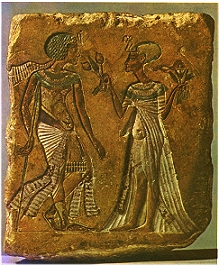 This
painted relief shows Smenkhkare and Meritaten taking a walk in
a garden. That later artwork has a relaxed, poetic mood about
it. This piece in particular seems carefree and relaxed, and portrays,
as many reliefs of the Amarna period did, a scene of intimate
daily life. This
painted relief shows Smenkhkare and Meritaten taking a walk in
a garden. That later artwork has a relaxed, poetic mood about
it. This piece in particular seems carefree and relaxed, and portrays,
as many reliefs of the Amarna period did, a scene of intimate
daily life.
Height 24 cm, Former National
Museums, Berlin
Image Source: Irmgard Woldering,
The Art of Egypt: The Time of the Pharaohs, New York: Greystone
Press, 1963, p. 111, plate 31.
Other versions on the web:
House in Tell el-Amarna
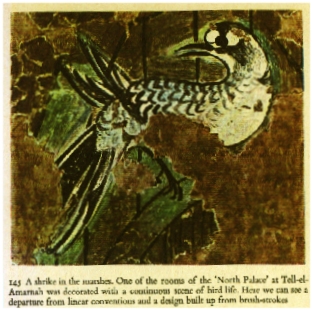 This
sweet-looking little bird was part of a room in the North Palace
at Amarna which was decorated with a huge scene of bird-life.
The relaxed brushstrokes building up the image seem out of place
in our conception of Egyptian art as monumental, static and powerful.
But evidently the Egyptians of the Amarna period were very interested
in portraying wildlife, as most of the palaces at Akhetaten are
profusely decorated with marsh and wildlife scenes, few of which
have survived the ravages of time in good condition, as the Egyptian
fresco was not true fresco (applied to dry rather than wet plaster)
and so is less durable. This
sweet-looking little bird was part of a room in the North Palace
at Amarna which was decorated with a huge scene of bird-life.
The relaxed brushstrokes building up the image seem out of place
in our conception of Egyptian art as monumental, static and powerful.
But evidently the Egyptians of the Amarna period were very interested
in portraying wildlife, as most of the palaces at Akhetaten are
profusely decorated with marsh and wildlife scenes, few of which
have survived the ravages of time in good condition, as the Egyptian
fresco was not true fresco (applied to dry rather than wet plaster)
and so is less durable.
Image source: Seton Lloyd,
The Art of the Ancient Near East, New York: Frederick A. Praeger,
1963, p. 183.
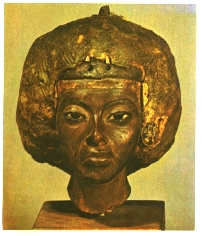 This
is a famous sculpture of Queen
Tiye. Beneath her apparently drab wig lies a silver and golden
headdress which was at one time covered up with this brown material,
and covered in blue glass beads, now missing. The golden nubs
sticking out were once part of cobras adorning her crown. (For
more about this, see Dorothea Arnold, The
Royal Women of Amarna, New York: The Metropolitan Museum of
Art, 1996) The stern look of the sculpted face is common in
representations of Queen Tiye. This
is a famous sculpture of Queen
Tiye. Beneath her apparently drab wig lies a silver and golden
headdress which was at one time covered up with this brown material,
and covered in blue glass beads, now missing. The golden nubs
sticking out were once part of cobras adorning her crown. (For
more about this, see Dorothea Arnold, The
Royal Women of Amarna, New York: The Metropolitan Museum of
Art, 1996) The stern look of the sculpted face is common in
representations of Queen Tiye.
Yew wood, Agyptisches Museum,
Berlin, from Medinet el-Ghurab
Image source: Irmgard Woldering,
The Art of Egypt: The Time of the Pharaohs, New York: Greystone
Press, 1963, p. 132.
 This
is a closeup of a famous stela (click here
for whole stela) showing Akhenaten and Nefertiti with some
of their children carved as miniature adults in their laps. It's
a touching family scene, one of the aspects of Amarna art that
makes it famous. I like the sure-of-itself style in this piece
-- it doesn't seem experimental anymore, nor is it at all willing
to change to suit the thousand-year-old standards of Egyptian
relief. I think especially in the lighting in this picture, it
looks a little alien, too. This
is a closeup of a famous stela (click here
for whole stela) showing Akhenaten and Nefertiti with some
of their children carved as miniature adults in their laps. It's
a touching family scene, one of the aspects of Amarna art that
makes it famous. I like the sure-of-itself style in this piece
-- it doesn't seem experimental anymore, nor is it at all willing
to change to suit the thousand-year-old standards of Egyptian
relief. I think especially in the lighting in this picture, it
looks a little alien, too.
Image source: Art
Images for College Teaching, items EN006
and EN008.
Other versions on the web: Ägyptisches
Museum und Papyrussammlung
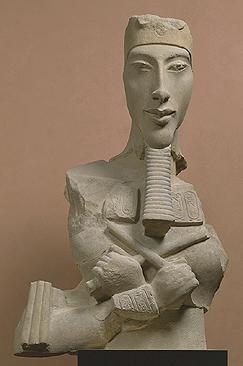 Many
people claim that Akhenaten was ugly, and had his artists paint
others as ugly too to make himself feel better. This seems ridiculous
to me - Akhenaten has a power in his unique look. I think this
fragmentary colossus shows particularly well his unique beauty.
With the expert help of David
Kennedy, this image was transformed into the Akhenaten you
see on my Introduction page. Many
people claim that Akhenaten was ugly, and had his artists paint
others as ugly too to make himself feel better. This seems ridiculous
to me - Akhenaten has a power in his unique look. I think this
fragmentary colossus shows particularly well his unique beauty.
With the expert help of David
Kennedy, this image was transformed into the Akhenaten you
see on my Introduction page.
Image source: I
don't remember. Please let me know if you find it on the web.
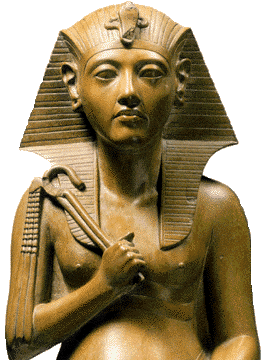 This
is another, very different, image of Akhenaten. This was carved
later in his reign (the previous image was carved much earlier),
and shows an almost sad person, to my eye. He once sat next to
Queen Nefertiti, whose arm still wraps around his back. This statue
was featured in the exhibition Pharaohs:
Treasures of Egyptian Art from the Louvre which I was fortunate
enough to see in Cleveland. This
is another, very different, image of Akhenaten. This was carved
later in his reign (the previous image was carved much earlier),
and shows an almost sad person, to my eye. He once sat next to
Queen Nefertiti, whose arm still wraps around his back. This statue
was featured in the exhibition Pharaohs:
Treasures of Egyptian Art from the Louvre which I was fortunate
enough to see in Cleveland.
Image source: Unknown,
but the same image can be found on the cover of: Lawrence M. Berman,
Bernadette Letellier, Pharaohs:
Treasures of Egyptian Art from the Louvre, Cleveland: Cleveland
Museum of Art, 1996
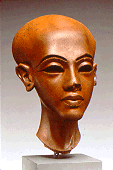 This
beautiful carved head was found at Amarna, still nearly perfect.
It was carved to represent one of the princesses and remains one
of my favourite amarna pieces. Unfortunately, I have only this
small picture at the moment. This
beautiful carved head was found at Amarna, still nearly perfect.
It was carved to represent one of the princesses and remains one
of my favourite amarna pieces. Unfortunately, I have only this
small picture at the moment.
Brown Quartzite, Agyptisches Museum, Berlin
Image source: Now-lost website of the
Royal Women of Amarna exhibition. See Dorothea Arnold, The
Royal Women of Amarna, New York: The Metropolitan Museum of
Art, 1996, fig. 48, p. 56.
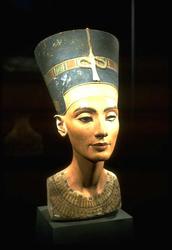 What
Amarna art gallery would be complete without the beautiful bust
of Nefertiti? And what needs be said? What
Amarna art gallery would be complete without the beautiful bust
of Nefertiti? And what needs be said?
Agyptisches Museum, Berlin
Image source: Art
Images for College Teaching, item EN010.
Other versions on the web: my
favourite, very
nice head-on with information - this one is all over the internet,
several views of the last
one ,
a pretty bad one.
Thanks for visiting our Gallery. I hope
you've developed a taste for the unique art of this little piece
of history. Now for more art of the Amarna period may I recommend:
|
![]()

 This
bright fresco from the palace in
This
bright fresco from the palace in  The
colossal statue of Akhenaten seen here as studied by Ray Winfield
Smith. This picture gives a feeling for the size of the statues
(from Karnak) and the perspective you see them through in real
life (Smith is standing on step-ladder, I believe).
The
colossal statue of Akhenaten seen here as studied by Ray Winfield
Smith. This picture gives a feeling for the size of the statues
(from Karnak) and the perspective you see them through in real
life (Smith is standing on step-ladder, I believe). Here
a first spirited gosling breaks free from an egg. This wooden
bird sat atop an unguent jar in Tutankhamun's tomb. It demonstrates
the attention paid by artists of the Amarna period to the nature
around them.
Here
a first spirited gosling breaks free from an egg. This wooden
bird sat atop an unguent jar in Tutankhamun's tomb. It demonstrates
the attention paid by artists of the Amarna period to the nature
around them. The
canopic-jar lids from Tutankhamun's tomb are particularly beautiful.
The art from Tutankhamun's tomb is thought to be in part a collection
of artifacts originally intended for Akhenaten, Nefertiti, or
other Amarna nobles, and demonstrates the art of the final phases
of the Amarna period.
The
canopic-jar lids from Tutankhamun's tomb are particularly beautiful.
The art from Tutankhamun's tomb is thought to be in part a collection
of artifacts originally intended for Akhenaten, Nefertiti, or
other Amarna nobles, and demonstrates the art of the final phases
of the Amarna period. This
unfortunately poor picture shows a young, idealist Pharaoh Akhenaten.
I see a rare innocent, hopeful look about this painted sandstone
piece, from his early reign.
This
unfortunately poor picture shows a young, idealist Pharaoh Akhenaten.
I see a rare innocent, hopeful look about this painted sandstone
piece, from his early reign. This
relief from a talatat block shows Nefertiti. Though we wouldn't
usually call these somewhat exaggerated features beautiful, it
shows her delicate features. This piece dates from Akhenaten's
early reign, at Karnak, when the new form of Amarna art was first
being experimented with.
This
relief from a talatat block shows Nefertiti. Though we wouldn't
usually call these somewhat exaggerated features beautiful, it
shows her delicate features. This piece dates from Akhenaten's
early reign, at Karnak, when the new form of Amarna art was first
being experimented with. This
touching little statuette of Akhenaten and Nefertiti is probably
from a domestic shrine in Akhetaten. The King and Queen are sweetly
holding hands. It is from somewhat later in their reign.
This
touching little statuette of Akhenaten and Nefertiti is probably
from a domestic shrine in Akhetaten. The King and Queen are sweetly
holding hands. It is from somewhat later in their reign.  This
is a floor-painting I believe is from Akhetaten (someone
This
is a floor-painting I believe is from Akhetaten (someone  This
painted relief shows Smenkhkare and Meritaten taking a walk in
a garden. That later artwork has a relaxed, poetic mood about
it. This piece in particular seems carefree and relaxed, and portrays,
as many reliefs of the Amarna period did, a scene of intimate
daily life.
This
painted relief shows Smenkhkare and Meritaten taking a walk in
a garden. That later artwork has a relaxed, poetic mood about
it. This piece in particular seems carefree and relaxed, and portrays,
as many reliefs of the Amarna period did, a scene of intimate
daily life. This
sweet-looking little bird was part of a room in the North Palace
at Amarna which was decorated with a huge scene of bird-life.
The relaxed brushstrokes building up the image seem out of place
in our conception of Egyptian art as monumental, static and powerful.
But evidently the Egyptians of the Amarna period were very interested
in portraying wildlife, as most of the palaces at Akhetaten are
profusely decorated with marsh and wildlife scenes, few of which
have survived the ravages of time in good condition, as the Egyptian
fresco was not true fresco (applied to dry rather than wet plaster)
and so is less durable.
This
sweet-looking little bird was part of a room in the North Palace
at Amarna which was decorated with a huge scene of bird-life.
The relaxed brushstrokes building up the image seem out of place
in our conception of Egyptian art as monumental, static and powerful.
But evidently the Egyptians of the Amarna period were very interested
in portraying wildlife, as most of the palaces at Akhetaten are
profusely decorated with marsh and wildlife scenes, few of which
have survived the ravages of time in good condition, as the Egyptian
fresco was not true fresco (applied to dry rather than wet plaster)
and so is less durable. This
is a famous sculpture of
This
is a famous sculpture of  This
is a closeup of a famous stela (
This
is a closeup of a famous stela ( Many
people claim that Akhenaten was ugly, and had his artists paint
others as ugly too to make himself feel better. This seems ridiculous
to me - Akhenaten has a power in his unique look. I think this
fragmentary colossus shows particularly well his unique beauty.
With the expert help of
Many
people claim that Akhenaten was ugly, and had his artists paint
others as ugly too to make himself feel better. This seems ridiculous
to me - Akhenaten has a power in his unique look. I think this
fragmentary colossus shows particularly well his unique beauty.
With the expert help of  This
is another, very different, image of Akhenaten. This was carved
later in his reign (the previous image was carved much earlier),
and shows an almost sad person, to my eye. He once sat next to
Queen Nefertiti, whose arm still wraps around his back. This statue
was featured in the exhibition
This
is another, very different, image of Akhenaten. This was carved
later in his reign (the previous image was carved much earlier),
and shows an almost sad person, to my eye. He once sat next to
Queen Nefertiti, whose arm still wraps around his back. This statue
was featured in the exhibition  This
beautiful carved head was found at Amarna, still nearly perfect.
It was carved to represent one of the princesses and remains one
of my favourite amarna pieces. Unfortunately, I have only this
small picture at the moment.
This
beautiful carved head was found at Amarna, still nearly perfect.
It was carved to represent one of the princesses and remains one
of my favourite amarna pieces. Unfortunately, I have only this
small picture at the moment. What
Amarna art gallery would be complete without the beautiful bust
of
What
Amarna art gallery would be complete without the beautiful bust
of